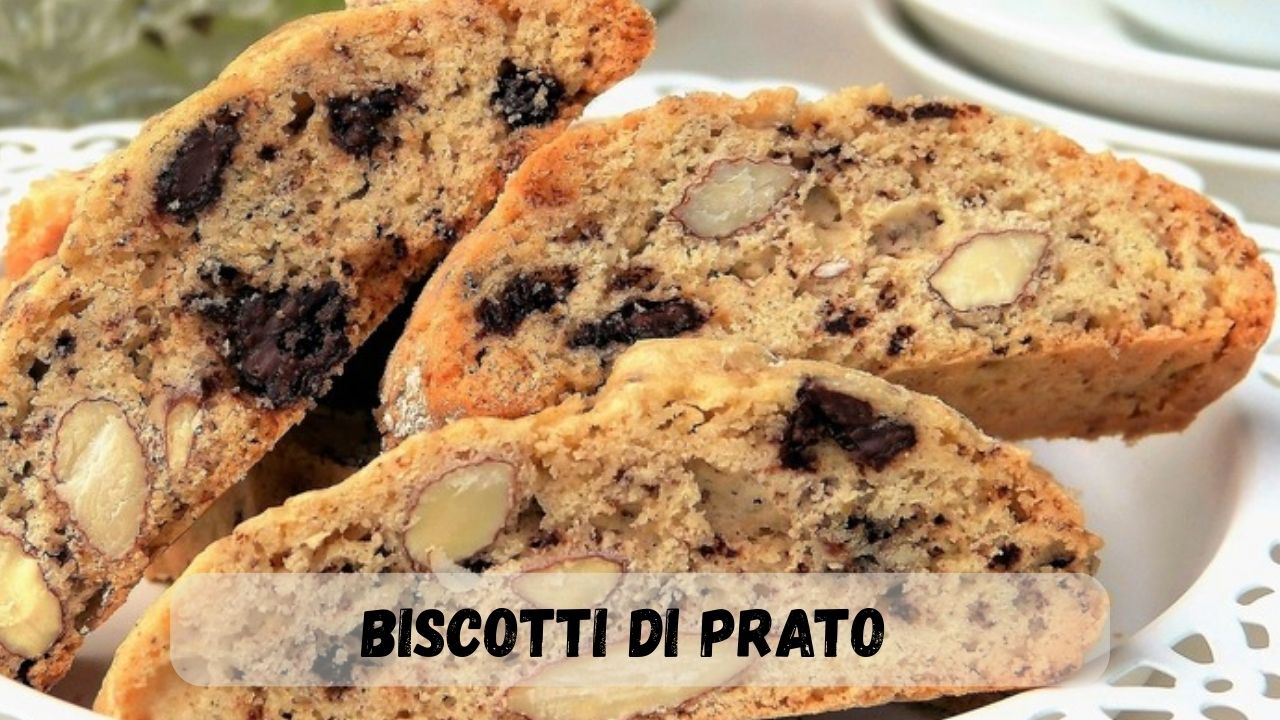Hey! Picture this: you’re in a sunny little town called Prato, Italy. You bite into a crunchy, nutty biscuit called Biscotti di Prato, or cantucci. Yum! These almond treats is a big part of Italian life. They’re often dunked in sweet Vin Santo wine. So good! People everywhere love them. In this article, we gonna explore their story, why they special, and how you can bake them at home. Ready for a tasty adventure
| Attribute | Details |
|---|---|
| Category | Twice-baked Italian almond biscuit (cookie) |
| Origin | City of Prato, Tuscany, Italy |
| Also known as | Cantucci / Cantuccini |
| Signature features | Oblong slices, golden crust, firm/crumbly, studded with whole almonds |
| Typical size | ~8–12 cm long; ~1–2 cm thick slices |
| Primary ingredients | Wheat flour, sugar, whole almonds (unblanched), eggs; no butter/oil in the classic style |
| Leavening | Traditionally none (relies on eggs); some modern versions use a little baking powder |
| Flavor profile | Nutty, toasty, lightly sweet; often scented with vanilla, citrus zest, or a splash of Vin Santo/anise |
| Production method | Mixed as a stiff dough → shaped into logs → first bake (to set) → sliced diagonally → second bake (to dry/crisp) |
| Serving tradition | Dipped in Vin Santo (Tuscan dessert wine); also with coffee, tea, or sweet wines |
| Texture target | Dry and crunchy (meant for dipping) with chewy almond pieces |
| Shelf life | Long—keeps well in an airtight tin (weeks) thanks to low moisture |
| Common variations | Pistachio; hazelnut; chocolate-chip; almond–orange; almond–anise |
| Allergen notes | Contains tree nuts (almonds), wheat (gluten), and eggs |
| Protected status | “Cantuccini Toscani” has EU PGI protection; “biscotti di Prato” is the historic/practical name linked to Prato’s tradition |
| Notable bakery | Biscottificio Antonio Mattei (Prato), often cited as a classic producer since the 19th century |
| Typical pairings | Vin Santo, espresso, cappuccino, sweet marsala, passito wines, gelato, ricotta-based desserts |
Historical Origins
Ciao! Imagine you in a sunny town called Prato, Italy. You munching on a crunchy Biscotti di Prato, or cantucci. So tasty! These biscuits got a cool story. Wanna hear it? Let’s jump in!
Ancient Beginnings
Long ago, Romans made biscoctus. It mean “twice-cooked.” Soldiers and travelers loved it. Why? It was tough and lasted forever. Perfect for adventures!
Prato’s Twist
By the 14th century, Prato folks got creative. They add local almonds. Yum! Those nuts made the biscuits super special. It was the start of cantucci!
Antonio Mattei’s Touch
In 1858, Antonio Mattei nailed it. He owned Biscottificio Antonio Mattei. His recipe was simple but awesome. Everybody loved his biscuits!
Paris Spotlight
In 1867, Antonio’s biscuits shined. They was at the Universal Exhibition in Paris. People from everywhere went crazy for them. Prato got famous!
Pandolfini’s Blue Bags
Now, the Pandolfini family keep the tradition going. They make biscuits at Antonio’s bakery. And guess what? They use cool blue packaging. You can’t miss it!
What Makes Biscotti di Prato SpecialCrunchy Cantucci: The Tasty Tale of Biscotti di Prato
Why these biscuits so awesome? They not just cookies. They got something special. Let’s check it out!
Super Simple Recipe
Biscotti di Prato use basic stuff. Flour, sugar, eggs, almonds. Sometimes pine nuts. No butter or yeast! It keep them light and crunchy. So real!
Twice-Baked Magic
Here’s the trick: they baked twice! First, a big dough log. Then, slice and bake again. This make them super crunchy. They last for months!
Tuscan Heart
These biscuits scream Tuscany. Big names like Pellegrino Artusi and Hermann Hesse loved them. They a piece of Tuscan soul.
Not Modern Biscotti
Today, some biscotti got chocolate or butter. Not Biscotti di Prato! They stick to the old way. Also, don’t call them “cantuccini.” Those is smaller and softer. Cantucci is the real stuff!
Why They’re Famous
Biscotti di Prato ain’t just big in Italy. They a world star! Here’s why everybody love them.
Real Tuscan Vibes
These biscuits is pure Tuscany. They keep the old recipe from Prato. Every bite feel like Tuscan history. That’s why they so loved!
Dip and Enjoy
They great for dipping. Try them in Vin Santo wine, coffee, or tea. The crunch gets just right. Plus, they last long, so perfect for trips or gifts.
World Inspiration
Biscotti di Prato sparked other treats. Spain got carquinyoli. France got croquant. In the 1990s, they blew up in the U.S. Coffee shops was full of them!
Tuscan Tradition
In Tuscany, these biscuits is more than food. They a fun ritual. At the end of dinner, you share with friends. Dip in wine, laugh, and chill. It all about good vibes!
How to Enjoy Biscotti di Prato
Ciao! Got some Biscotti di Prato in your hand? Lucky you! These crunchy almond treats from Prato, Italy is so fun to eat. Not sure how to enjoy them? Let’s dive into the tasty ways to savor cantucci!
Classic Dipping Fun
The best way to eat Biscotti di Prato? Dip them in Vin Santo wine. This sweet Tuscan wine make the biscuit soften just right. Yum! No Vin Santo? No problem! Try dipping in espresso, Marsala wine, or even milk. It all delicious!
When to Munch
These biscuits is super versatile. Eat them for breakfast with coffee. So good to start the day! Want a sweet dessert? Serve after dinner. Or just snack on them anytime. They always hit the spot!
Keep Them Fresh
Wanna keep that crunch? Store your biscotti in an airtight container. They stay fresh for weeks! No fridge needed. Just keep them dry and sealed. You can enjoy them anytime you want!
Making Biscotti di Prato at Home
Ever dream of baking Biscotti di Prato yourself? It’s easier than you think! Let’s follow the traditional recipe from Biscottificio Antonio Mattei. Get ready to make some crunchy magic in your kitchen!
The Classic Recipe
Antonio Mattei’s recipe is super simple. You need flour, sugar, eggs, unroasted almonds, and maybe some pine nuts. No butter, no oil, no yeast. That’s the secret to real cantucci. Keep it basic for that true Tuscan vibe!
Step-by-Step Baking
Here’s how you make them. It fun and easy!
- Mix the Dough: Grab a bowl. Mix flour, sugar, and eggs. Toss in whole unroasted almonds. Add pine nuts if you like. Stir until you got a sticky dough. Don’t overmix!
- Shape the Logs: Sprinkle flour on a table. Form the dough into long, flat logs. About two inches wide. Place them on a baking sheet. Ready for the oven!
- First Bake: Heat your oven to 450°F. Bake the logs for 15-20 minutes. They turn golden and firm. Let them cool a bit so they don’t crumble.
- Slice and Bake Again: Cut the logs into diagonal slices, about half-inch thick. Lay them flat on the baking sheet. Bake again at 300°F for 10-15 minutes. Flip halfway for even crunch. Now you got that perfect crisp!
Tips for Authentic Biscotti
Wanna make them like a true Tuscan? Don’t add fancy stuff like chocolate or fruit. Stick to almonds and maybe pine nuts. Use unroasted nuts for that classic flavor. Keep it simple, and you’ll taste Prato in every bite!
Cultural and Modern Impact
Biscotti di Prato ain’t just a cookie. They a piece of Tuscan heart! Let’s see how they keep shining in Italy and beyond.
A Pilgrimage to Prato
Love biscotti? You gotta visit Biscottificio Antonio Mattei in Prato. It like a holy spot for biscuit fans! People come from everywhere to try the real deal. Those blue bags is iconic!
Modern Twists vs. Tradition
Some folks get creative with biscotti. They dip them in chocolate or add dried fruit. Tasty, but not classic! True Biscotti di Prato stick to the old recipe. Purists say that’s the only way. What you think?
Global Biscotti Love
These biscuits travel the world! They inspired treats like Spanish carquinyoli and French croquant. In the 1990s, they took over U.S. coffee shops. Today, you find them everywhere. Tuscany’s gift keep on giving!
Conclusion
Ciao! We just took a fun trip through the world of Biscotti di Prato! These crunchy almond goodies from Prato, Italy got a story that go way back to Roman times. They was perfected by Antonio Mattei at Biscottificio Antonio Mattei and still loved today. Why so special? They simple, twice-baked, and perfect for dipping in Vin Santo wine. From Tuscan tables to coffee shops around the world, they bring smiles and good vibes. Now you know how to enjoy them, bake them, and why they a big deal. So, grab some cantucci, dip them, or bake your own. It a delicious way to taste Tuscany’s soul, right?








